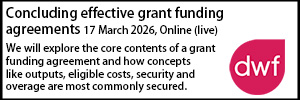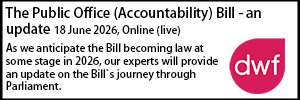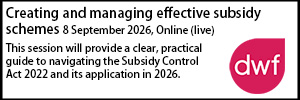The ESPD: what do you need to do?
- Details
 The European Single Procurement Document came into force from 26 January 2016. Ruth Smith explains what it entails and the issues that remain unresolved.
The European Single Procurement Document came into force from 26 January 2016. Ruth Smith explains what it entails and the issues that remain unresolved.
Regulation 59 of the Public Contracts Regulations 2015 (“PCR 2015”) requires contracting authorities to accept a European Single Procurement Document (“ESPD”) from bidders as part of the selection process.
This implements a similar provision in the new Public Contracts Directive 2014/24, the aim of which is to reduce the administrative burden on bidders and contracting authorities by simplifying the manner in which information and evidence is provided at selection stage. It is effectively a self-certification of good standing that the bidder does not fall within any of the exclusionary grounds and has the necessary economic/financial standing and technical and professional ability. It is intended to reduce the amount of documentation required from bidders at an early stage by avoiding the need for bidders to submit additional evidence and documentation in support of the statements made in the ESPD. This evidence and supporting documentation can then be requested by the contracting authority at any point “where it is necessary to ensure the proper conduct of the procedure”.
An example of when this may be the case is given at Recital 84 of the Directive which suggests that, in the case of two-stage procedures (e.g. restricted, competitive dialogue etc.) when making a short-listing decision, the submission of supporting information from the short-listed bidders may be justified to avoid selecting candidates which later prove ineligible. The contracting authority must also request the up to date supporting evidence and documentation from the bidder to be awarded the contract.
The European Commission has recently published an Implementing Regulation, which for the first time sets out a standard form for the ESPD, which (as we understand it) each member state will adopt. It brings into force, from 26 January 2016 in England and Wales, the obligation on contracting authorities to accept the ESPD from bidders as preliminary evidence instead of certificates issued by public bodies or third parties (e.g. banks) to confirm that the bidder:
- is not in breach of one of the mandatory or discretionary exclusion criteria;
- meets the selection criteria set out at Regulation 58 (suitability to perform the contract, economic and financial standing and technical and professional ability); and
- where applicable, meets the objective and non-discriminatory criteria that the authority is going to apply to reduce the numbers who are invited to bid.
Ultimately, the ESPD will be available in an online format only but the PCR 2015 state that the “online only” requirement is to be delayed until April 2017; until then, paper/Word copies may be used.
How will the ESPD work in practice?
At the time of writing we have not yet had the benefit of any guidance from the UK government so to some extent the answer to this question is that we don’t yet know. However, there are a few pointers we can give at this stage:
- The Regulation 59 obligation on contracting authorities is simply to accept ESPDs sent to them by bidders;
- The obligation applies to contracting authorities from 26 January 2016 (though it is as yet unclear whether it applies to procurements already under way at that date or only to those advertised on or after that date). Note that the obligation will not apply to Utilities running a procurement until the Utilities Contracts Regulations 2016 come into force (on 18 April 2016);
- The Implementing Regulation states that the contracting authority OJEU/call for competition must reference what information the ESPD will require, and that the intention is for ESPDs to be submitted with the tender in an Open procedures and with the Request to Participate in others; and
- Member states can require use of (or can leave it to contracting authorities to decide whether to use) an ESPD in a below-threshold or Light Touch procurement. Given the relatively “hands-off” approach the government took to implementing the Public Contracts Regulations 2015 in general, it seems likely that here the government may opt to leave this decision to contracting authorities on a case by case basis.
Obviously, some key questions remain unanswered, particularly the issue of how in practice the use of the ESPD is meant to fit together with the Crown Commercial Service’s (CCS) standard Pre-Qualification Questionnaire (PQQ). Both cover much of the same ground, and it would seem to defeat the object of the ESPD and create more room for error or ambiguity if bidders are now required to complete two documents where previously only one was needed. We have had a steer from the CCS to the effect that it is “currently discussing the most suitable option for ensuring that government's guidance and standard documents on selection are aligned with the ESPD. A PPN and accompanying guidance will be published shortly. In the interim the advice in PPN03/15, the supplier selection guidance and the standard PQQ template should continue to be used until the policy and guidance on the aligned ESPD/PQQ are published.”
What should contracting authorities do now?
Obviously, do keep an eye out for the CCS guidance and PPN which will hopefully resolve some of the questions around how the ESPD will work in practice here.
Otherwise, given that the Regulation 59 obligation is to accept ESPDs from January 2016, a failure to do so would amount to a technical breach of the Regulations. Therefore it is worth briefing procurement staff internally about the standard format of the ESPD, its purpose and the possibility that ESPDs will be received, and should be accepted. Having said that, it is perhaps unlikely that bidders will be ready to submit ESPDs in the near future, particularly if, following the CCS steer around continuing to use the standard PQQ for now, contracting authorities do not prompt this by referencing the use of ESPDs in the OJEU or call for competition.
However, contracting authorities should take care to avoid any wording in their procurement documents which either expressly or by inference actively prohibits a bidder from submitting an ESPD on or after 26 January 2016, since the obligation to accept these will be “live” from that point. For example, if the conditions accompanying a PQQ or ITT state that a PQQ or Tender response may be rejected if it is not in the format specified, and the specified format does not take account of the possibility of some of the information being contained within an ESPD then the drafting should be amended to take account of this.
Once the CCS guidance is available, it is likely that a review of standard procurement documents will be needed, to ensure these work together with the ESPD process. There are likely be consequential amendments to the standard form PQQ document. Also, standard form ITTs may need revision (as discussed above and, for example, to reflect the obligation at Regulation 54(4) to ensure that ITTs reference the evidence and supporting documents that will have to be submitted in due course to verify the preliminary statements made in the ESPD).
We will post here again with further analysis and practical tips around use of the ESPD, once the CCS guidance is available.
Ruth Smith is National Head of Procurement Law at Mills & Reeve. She can be contacted on 01223 222585 or
Sponsored articles
Walker Morris supports Tower Hamlets Council in first known Remediation Contribution Order application issued by local authority
Unlocking legal talent
Legal Director - Government and Public Sector
Contracts Lawyer
Lawyer (Planning and Regulatory)
Locums
Poll
15-07-2026 11:00 am














































